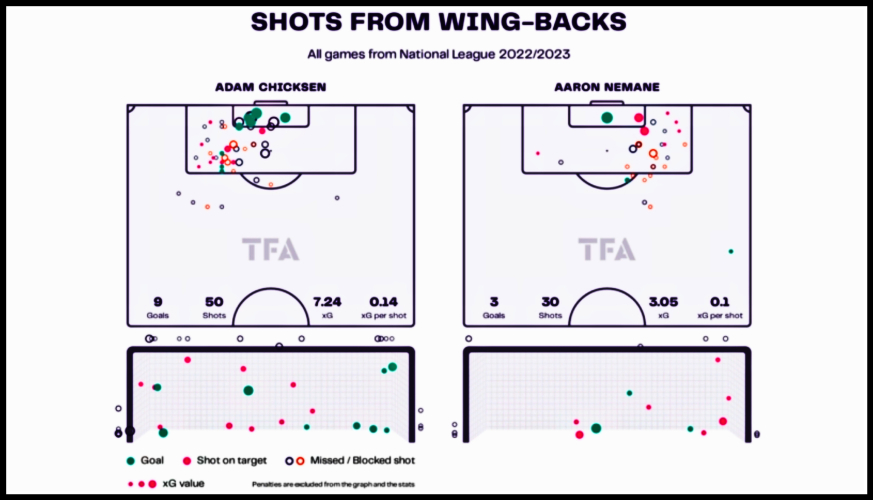Luke Williams analysed : The cause, the effect and the outcome
Tuesday, 9th Jan 2024 08:00 by ©️Trystan Bending : X @TrystanBending Trystan Bending returns once more with some deep insight in to Luke Williams, and today we see the fruits of his investigations. Fully explained and done so dynamically and accurately this feature will explain a lot to the Swans fan wanting to know more about Luke and his strategic thinking.
Luke Williams was announced as the new Swansea City manager on Friday morning. Williams, previously at Notts County, is undoubtedly a manager with a unique set up, fresh ideas and a lot to prove. Williams leaves County with an impressive 60% win rate over 80 games. There is certainly a lot of careful thought behind William’s beliefs and tactics. In this article I will attempt to dissect everything we can expect to see from Swansea as we enter a new era under Luke Williams.
How can we expect to set up under Luke Williams ?
Typically in a Luke Williams setup he has favoured a 3-4-2-1 formation. Williams tactics entail so much detail, in and out of possession, due to a demand for constant change of movement across the pitch, that the formation will prove to be ever changing across a full ninety minutes. We will see the three centre backs split and Carl Rushworth will also be asked a lot to play as a sweeper type goalkeeper, which we will look into in more detail later on. The middle of the three centre backs will act as a more conservative type centre back and the two either side will occupy ball playing roles. The left wing back and right wing back in this system will play very high and wide, almost playing as wingers. Notts County players Jodi Jones and Aaron Nemane have picked up a number of goal contributions this season in the EFL League Two, due to the freedom they have been given. Williams will causally play two in the middle, which you will easily be able to identify on the pitch. Williams will look to build a week in week out partnership between the two holding midfielders, aiming to solidify a partnership that can perform every week, as demonstrated with Matty Palmer and John Bostock. The two advanced players will occupy the edges of the D and link with the wing-backs. We can expect our number 9 in this system to not have too much instructions other then to run hard and be clinical in the box.
 Williams team averaged 69.1% possession per 90 last season in the Vanarama National League. This season his side has averaged 67.7% possession in the EFL League Two. The objective Luke Williams sets out for his team is to dominate possession and dictate the tempo of the match. Despite the slow build up, Williams has managed success by implementing a capacity to increase the tempo at any time whilst building an attack. This leads to an easy improvement in exploiting space in behind and around the box that the opponent has failed to defend.
Interchanging positions
When County have been in their favoured 3-4-2-1 formation positional rotation has been essential when they are in the wider areas. To make this work, multiple players will interchange on the flank to ensure they can dominate possession when isolated on the flanks. For example when one wing back is high and wide, the attacking midfielder will be tucked inside in a narrower position. The aim of this is to drag opponents out wide and out of position and look to find the space left behind, or take advantage of an unorganised defence.
 The role of the wing backs
Luke Williams will without doubt look to utilise players Josh Key and Josh Tymon as much as possible in both wing back positions. Both should be excited by the opportunity to play so high in William’s favoured 3-4-2-1 shape. Interchanging positions is a key part of the first phase, and when looking at how county move into the mid phase it really identifies the relationship between wing back and corresponding attacking midfielder as the most important part of his system. We can expect both wing backs to show no hesitation when progressing into high attacking positions. The wing back on the side of play will always look to make a run past the opposition’s full back. Close to his position will be the corresponding attacking midfielder. When the final ball is played, the other wing back stays occupied by making a darting run forward into the final third, with no interest in dropping deep to defend. This is a recurring feature of William’s tactics and it often leads to dangerous chances from wider areas. Adam Chicksen recorded 50 shots in the National League 22/23 season from left wing back. Aaron Nemane on the opposite flank recoded 30 shots. Between them they scored 12 goals. With the quality of Key and Tymon you’d expect the return to be higher.
 Attacking Centre backs
Such a possession based style of football often drives the opposition deep within their own half. This will leave more space for Swansea to commit players forward. This will allow our right Centre back and left centre back to commit into midfield. The wider centre backs will always be slightly higher then the central one. This provides a better angle for the pass, and also opens up the option for them to carry the ball in the first phase. With the rest of the team higher up the pitch we can expect the three centre backs to be left unmarked. This gives them the ability to be left free and play direct passes into the box. Kyle Cameron, County captain provided a significant amount of passes into the penalty area, presented below. We can expect this from either of our wide centre backs.
 Defending Out of Possession ?
Whilst Williams Notts County have dominated on the possession front it is important to explore the side out of possession. It’s no secret that Notts County have been very successful in scoring a lot of goals, however their major downfall across the two seasons has been the lack of clean sheets. They have conceded the fourth most goals this season in the EFL League Two, which is a statistic that Swansea fans will have slight concern over. The majority of goals, have been conceded from counter attacking opportunities from the opposition as they look to quickly break from Williams side dominance in possession, and attack positions up the field. And this be will what teams will look to do against Swansea this year under Williams. Notts County have converted their attacking 3-4-2-1 formation into a rigid 5-4-1 formation when in defence. When the team have been able to defend in numbers, it’s proved to be hard to break down. One thing Swansea fans should keep in mind is of course the step up from League Two to the Championship. Whilst Williams will certainly look to secure his defensive issues, there’s no denying that Swanseas back line offer much more quality compared to Notts County’s defence. This should in theory limit the type of rash decisions that County have fallen victim to, with less mistakes at the back, reducing the chances of conceding. We will also see a quick press if we do loose the ball high up the field, demanding the players to instantly win the ball back.
Role of the attacking midfielders & the number 9
Whilst the interchanging positioning with the wing backs is so important, Luke Williams has mastered giving his two 10s the ability to roam into narrow and wide spaces all the time. County have averaged 12.2 shots per game and 2.7 big chances per game.
Let’s have a look at how Williams develops the attack and the important role of each individual
Once Swansea have beaten the press and have broken out it will often look like a 3-2 beneath the attacking players. This is where the 10s are so important. When a more defensive midfielder has hold of the ball it will almost look like a perfect square, with the 10s shaping a square in front of the midfielders. The two advanced midfielders will always do a give and go with the wing-backs and then drill crosses usually towards the penalty area.
The role of the number 9 in this system and one that Macaulay Langstaff has done so well in this League 2 campaign is to drag defenders out wide and create space for the wing backs and the more attacking midfielder, in this seasons case McGoldrick. It leaves the number 9 with a very free role, which has provided Langstaff with a lot more chances this season. Before this season his role was very simple. He would sit on the last man and sit between the sticks, and find his goals in a vey rigid structure. This instruction will not work in the championship, I’d expect Williams to operate the new free role for our number 9.
The infamous corners
Notts County are one of the highest scoring sides from corners in the EFL. The idea is a player will always come short to receive the ball, and essentially restart the passage of play from a wide position and work their way gradually towards the box. This has proved to be overwhelmingly effective for County, however, teams have quickly jumped to prevent this. This season in particular two opposing players have run straight to the flag to prevent a short corner. In this position Williams has opted to put the ball in the box rather then a short corner.
 Rushworth role ?
Rushworth won’t be left alone in the surge to move the tram up the field and push the opposition back as much as possible. He’ll be responsible for finding the space when teams sit back with 11 men behind the ball. At times as crazy as it sounds Rushworth will be occupying as the deepest defender. He will need to be brave to take the ball under control outside of his area. He’ll need to spread the play to the wing backs, find midfielders with short passes, whilst being in a position to receive it at the same time.
Will We see the best from Captain Matt Grimes ?
Grimes will have undoubtedly have studied Williams game and in doing so he will have quickly noticed that he’ll be involved in absolutely everything under Williams. Both in and out of possession. Grimes will need to quickly control, hold up, and work the ball into spaces that benefit the other players around him. He can drop back, work to win the ball back, and get it forward. He will also have to offer support to players further forward to give them a chance to move into space themselves. In attack he will need to find space at the edge of opposition's penalty box and put a carefully timed ball in behind for Key or Tymon and come out wider to assist with crossing the ball if needed. When the two 10s are being marked, it will leave Grimes essentially isolated to pick up and move on with the ball. There’s no doubt Palmer has been integral to the successes of Luke Williams. You can see from his heat map (below) that he travelled to every inch of the pitch last year. It does also put emphasis on how important fitness levels will be to carry out this job. In conclusion. This deep lying play maker role suits the captain immensely well. I really think Williams could well get the best out of him, if we haven’t seen that already.
  Photographs Open Source & TFA / The Athletic
Please report offensive, libellous or inappropriate posts by using the links provided.
You need to login in order to post your comments | 






